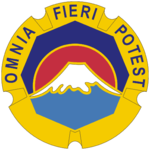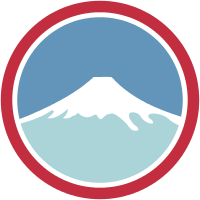United States Army, Japan
| United States Army, Japan | |
|---|---|
|
United States Army, Japan shoulder sleeve insignia | |
| Active | 1 July 1957–present |
| Country |
|
| Branch |
|
| Part of |
United States Forces, Japan United States Army Pacific |
| Garrison/HQ | Camp Zama, Japan |
| Motto(s) | Omnia Fieri Potest |
| Commanders | |
| Current Commander | Major General James F. Pasquarette |
| Notable commanders | Roscoe Robinson Jr., James C. Boozer Sr. |
| Insignia | |
| Distinctive Unit Insignia |
 |
United States Army, Japan (USARJ) consists of about 2,000 soldiers and is charged, during peacetime, with operating port facilities and a series of logistics installations throughout Honshū and Okinawa. USARJ participates actively with the Japan Ground Self-Defense Force in bilateral training exercises and the development of bilateral plans. It commands and supports United States Army assigned units, attached units, and augmentation forces and employs these forces in support of the commander. USARJ maintains and strengthens the credibility of deterrent power in the Pacific through maintenance of defense facilities, war reserves and operational project stocks. USARJ is headquartered at Camp Zama.
As the Army Component Command to United States Forces Japan (USFJ) and as a Major Subordinate Command of United States Army Pacific (USARPAC), United States Army Japan (USARJ)/I Corps (Forward) is responsible to provide support of Article V (Defense of Japan) and VI (ensuring regional stability) of the Mutual Security Treaty (MST). It serves as a forward stationed Army command and control headquarters; supports regional security cooperation activities with the Japan Ground Self Defense Force (JGSDF) for the purpose of contributing to the security of Japan and maintenance of peace and security in the Far East; provides communities of excellence and installation operations that support Soldiers, Civilians, and their Families.
United States Army, Japan consists of:
- U.S. Army Garrison, Japan
- 10th Support Group, Okinawa, Japan
- U.S. Army Corps of Engineers, Japan District
- U.S. Army Japan Band
- U.S. Army Aviation Battalion Japan
History
United States Army Japan (USARJ) can be traced back to the U.S. Army Forces, Far East, which was formed in Manila in July 1941. Commanded by General of the Army Douglas MacArthur, the headquarters (HQ) moved to Australia in 1942. After the war, the headquarters first moved to Tokyo, then to Yokohama in 1953, and finally to its present location on Camp Zama in October 1953.
Reorganization of U.S. forces in the Pacific in January 1953 established Army Forces Far East as the major Army command in the Far East. AFFE moved to Camp Zama, 35 miles southwest of Tokyo, in October 1953 into a new headquarters building designed by Antonin Raymond. On 20 November 1954, AFFE was combined with the Eighth US Army to become AFFE/Eighth US Army. In 1955, the Eighth US Army moved its headquarters to Yongsan Garrison, Seoul, Korea, and the Camp Zama command element was designated AFFE/Eighth US Army (Rear). The name, US Army Japan (USARJ), first appeared on 1 July 1957 in a reorganization of US forces in the Pacific.
On July 1, 1957, a U.S. Forces reorganization in the Pacific designated USARJ as one of the major subordinate commands of U.S. Army Pacific (USARPAC) in Hawaii. Reorganized again on September 1, 1968, USARJ employed a new structure to maximize operational efficiency while keeping its existing missions and functions.
The reversion of Okinawa to Japanese control on May 15, 1972, resulted in the realignment of the Pacific Army commands with HQ USARJ absorbing elements for Okinawa and providing improved structure for command and control. Under the complex reversion, IX Corps was transferred from Okinawa and collocated with this command to become HQ USARJ/IX Corps.
On July 1, 1974, a USARJ reorganization established three subordinate commands: U.S. Army Garrison, Honshu (USAGH); U.S. Army Garrison, Okinawa (USAGO); and the U.S. Army Medical Department Activity-Japan, (MEDDAC-JAPAN). With the discontinuance of USARPAC, USARJ was designated a major Army command on January 1, 1975, reporting directly to Department of the Army.
In August 1990, USARPAC was reestablished and USARJ became a major subordinate command of that headquarters as well as continuing as the Army Component Command of U.S. Forces, Japan (USFJ). In 1994, IX Corps was replaced by 9th Theater Army Area Command and on November 8, 1999, was redesignated 9th Theater Support Command (TSC). There were several minor reorganizations and redesignations over the next decade so that by September 11, 2001, USARJ consisted of logistics bases in Japan and Okinawa.
In September 2007, the 9th TSC was inactivated and on December 19, 2007, I Corps (Forward) was activated in Japan in line with the Army’s transformation efforts. USARJ remains headquartered at Camp Zama, where it engages in numerous bilateral activities with the Japan Ground Self-Defense Force (JGSDF) and performs duties as the Army Component Command to USFJ.
On March 11, 2011, a devastating magnitude 9.0 earthquake and tsunami struck the northeast coast of Japan. Within minutes, USARJ began humanitarian assistance and disaster relief operations in support of the JGSDF during Operation Tomodachi, Japan’s largest-ever bilateral operation. USARJ supported the affected people after operations officially ended by providing equipment and maintenance support to the JGSDF until September.
References
| Wikimedia Commons has media related to United States Army in Japan. |
![]() This article incorporates public domain material from the United States Government document "".
This article incorporates public domain material from the United States Government document "".
